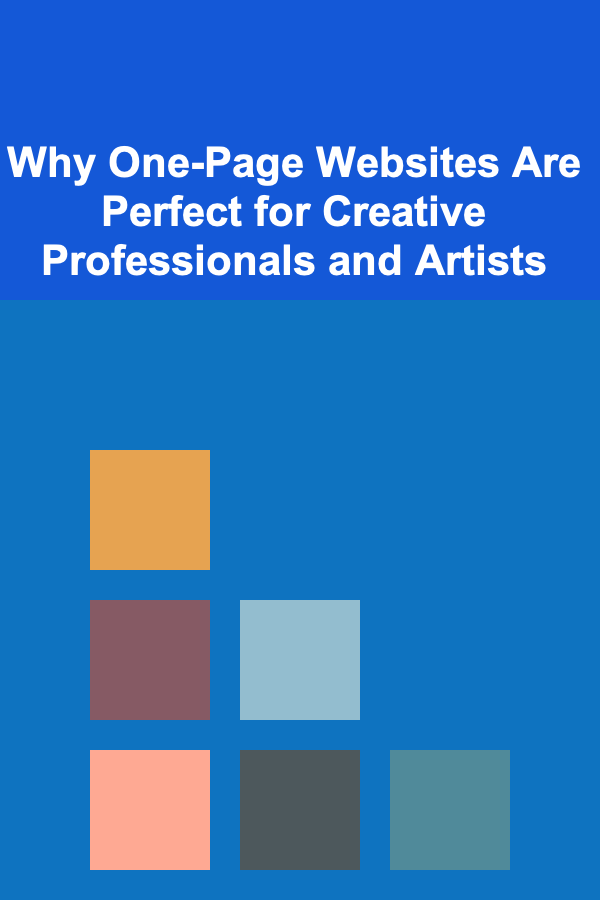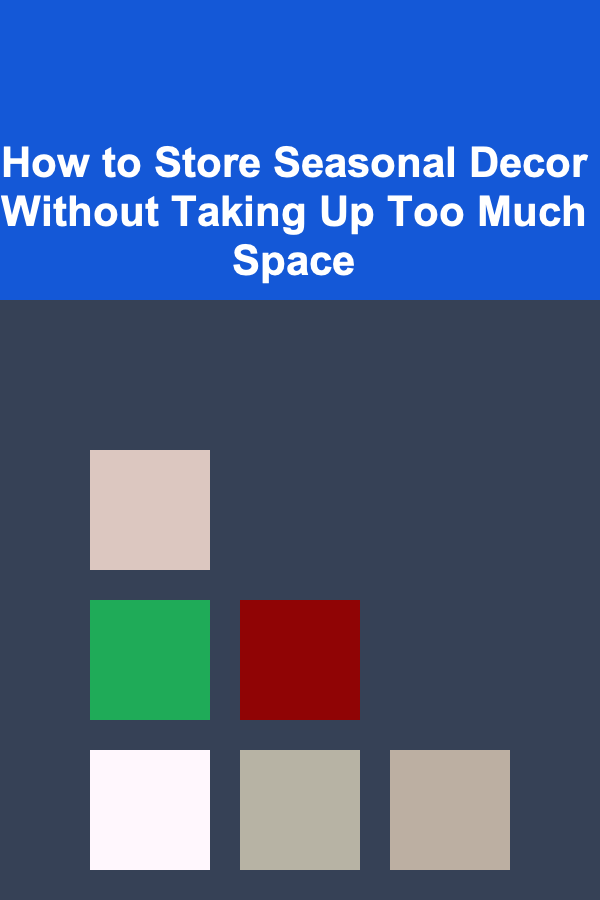
Why One-Page Websites Are Perfect for Creative Professionals and Artists
ebook include PDF & Audio bundle (Micro Guide)
$12.99$9.99
Limited Time Offer! Order within the next:

In the ever-evolving world of digital presence, creative professionals and artists often seek ways to showcase their work in a manner that's both engaging and functional. One-page websites have emerged as an ideal solution for this, combining simplicity with high impact. With the rise of minimalist web design and the increasing importance of user experience (UX), one-page websites have become the go-to platform for showcasing portfolios, offering services, or displaying artwork.
This article explores why one-page websites are perfect for creative professionals and artists, touching on various aspects of design, user engagement, functionality, and marketing. We will discuss how this web format serves the unique needs of artists and creative professionals, examining its role in enhancing visibility, offering an optimal user experience, and providing flexibility for diverse creative endeavors.
Simplicity and Focus: A Streamlined Experience
For artists and creatives, the primary goal of a website is often to showcase their work in the most impactful way possible. One-page websites excel in this area by stripping away the unnecessary clutter found in traditional multi-page sites. With a one-page design, the user is immediately immersed in the work itself, without being distracted by excessive navigation or extraneous information. This simplicity is a huge asset for artists who want to convey their creative vision without overwhelming the viewer with too many choices.
Minimalism as a Tool for Impact
One-page websites embody minimalism in design, a trend that has become increasingly popular in the creative industry. By focusing on just one page, designers can create a clean, streamlined experience that emphasizes the artwork or portfolio items. This design philosophy allows the artist's work to take center stage, whether it's a series of paintings, photographs, digital art, or other creative expressions. The minimalistic approach also means that every design choice, from typography to color schemes, is intentional and enhances the work rather than competing with it.
Eliminating Distractions
One of the most powerful aspects of a one-page website is its ability to remove distractions. Traditional websites often contain multiple pages with varying levels of content, each requiring navigation to access. This can create a disjointed experience for visitors. On a one-page site, users can scroll through the entire experience without clicking or waiting for new pages to load. This keeps their focus on the work itself, rather than on navigating between various sections or getting lost in a maze of content.
Engagement and User Interaction
For creative professionals and artists, the connection they form with their audience is vital. One-page websites are designed with engagement in mind, offering smooth, intuitive interactions that help build a stronger connection between the artist and the viewer. The continuous, scrollable format of a one-page website is conducive to storytelling and guiding the user through the artist's journey, providing a more immersive experience.
Seamless User Experience
One-page websites offer a seamless user experience that is critical for keeping potential clients or admirers engaged. Unlike multi-page sites, where users might get lost or frustrated trying to find what they're looking for, one-page sites have all the content right at the user's fingertips. This design is particularly beneficial for artists, as it ensures that the viewer's attention is directed exactly where it needs to be at any given moment. Through smooth transitions, animated scroll effects, and clear content flow, a one-page website offers an experience that feels cohesive and effortless.
Storytelling Through Design
For many artists and creatives, their work tells a story. One-page websites are perfect for presenting this narrative in a way that's visually compelling. The scrolling format encourages the use of visual storytelling, where users can be guided through different aspects of the artist's journey. Whether it's the progression of an art piece, a behind-the-scenes look at the creative process, or a step-by-step showcase of various projects, the design of a one-page website allows for an engaging narrative that unfolds naturally as users scroll down the page.
Interactive Features for Deeper Engagement
Modern one-page websites often incorporate interactive features, such as hover effects, animations, and embedded media. These features enhance user engagement by making the site more dynamic and visually stimulating. For artists, this provides an opportunity to showcase their work in innovative ways---through interactive galleries, image sliders, and video backgrounds that demonstrate the depth and range of their creative abilities. These interactive elements help to create a memorable experience for the user, encouraging them to spend more time on the site and explore the artist's work further.
Mobile-First Design and Accessibility
As more people browse the web on mobile devices, it's essential that websites cater to mobile users. One-page websites are inherently better suited for mobile-first design, as their simple layout adapts seamlessly to smaller screens. For artists and creative professionals, this means that their portfolios or artwork will be just as effective on a smartphone as it is on a desktop computer. The streamlined design of one-page websites ensures that users can navigate through content easily on any device without sacrificing visual appeal or functionality.
Adapting to Mobile Devices
With a mobile-first design, a one-page website automatically adjusts to the size of the screen it is viewed on. Whether it's a tablet, smartphone, or desktop, the content reflows and resizes to fit, ensuring that the user experience is optimized for each device. This is particularly important for artists, as their work often involves rich imagery that can benefit from a responsive layout. One-page websites ensure that images and media load correctly and are presented in their full glory, without distortion or the need for the user to zoom in.
Speed and Performance Optimization
In the world of mobile browsing, speed is everything. Users expect websites to load quickly, especially when accessing them on mobile devices. One-page websites tend to load faster than multi-page sites because they only have one page to render. This is a significant advantage for artists and creatives, as slow-loading sites can lead to higher bounce rates and decreased engagement. With faster load times, visitors are more likely to stay on the site longer, increasing the chances of conversion---whether that means a purchase, a project inquiry, or simply a deeper exploration of the artist's work.
Easy Navigation and Clean Layouts
The ease of navigation is another key reason why one-page websites are perfect for creative professionals. Traditional websites often have complex menu structures and require users to click through multiple pages to find what they're looking for. In contrast, one-page websites offer a simple, linear experience where users can scroll through content at their own pace. The lack of complicated navigation helps to streamline the user journey and encourages a more fluid, enjoyable interaction.
Clear, Direct Layouts
One-page websites inherently feature clear, direct layouts that eliminate the need for complex menus. All information is presented on a single, easy-to-navigate page, which means visitors don't have to search for specific sections or struggle to find what they need. For artists, this is particularly beneficial, as it means that their portfolio, biography, and contact information can all be displayed in a clear, straightforward manner without clutter. The layout can be organized with well-defined sections, each dedicated to a specific aspect of the artist's work, ensuring that users can easily explore the portfolio and learn more about the artist.
Smooth Scrolling and Anchored Navigation
To further enhance the navigation experience, one-page websites often incorporate smooth scrolling and anchored navigation. Anchored navigation allows users to jump to different sections of the page by clicking on menu items or scrolling to specific points. This is particularly useful for one-page websites that have a lot of content, as it allows users to easily navigate to the information that's most relevant to them. Whether they're looking at an artist's bio, browsing through artwork, or checking out available services, anchored navigation ensures that the user experience is intuitive and frictionless.
Affordable and Time-Efficient Design
For many artists and creative professionals, cost and time are significant considerations when building a website. One-page websites offer a budget-friendly and time-efficient solution for those looking to establish an online presence without breaking the bank or spending months on development. The simplicity of a one-page design means that it often takes less time to build and deploy compared to multi-page websites, making it an ideal choice for those who need a professional online presence quickly.
Lower Development Costs
Since one-page websites are less complex than traditional websites, they tend to be more affordable to design and develop. Artists and creatives often operate on tight budgets, and a one-page website provides a cost-effective solution that still offers a professional look and feel. Furthermore, many website builders and templates cater to one-page designs, making it even easier and more affordable to create a website without needing to hire a developer.
Quick Launch Time
Time is a precious resource for artists, especially when they are juggling multiple creative projects. One-page websites can be launched in a fraction of the time it would take to develop a multi-page site. With pre-built templates and intuitive website builders available, artists can quickly set up their online portfolio, make adjustments, and publish their site within a short timeframe. This allows them to focus on their craft rather than getting bogged down by technical details.
SEO Benefits
Search engine optimization (SEO) is critical for ensuring that your website ranks well in search engine results and attracts traffic. One-page websites are often easier to optimize for search engines because all of the content is concentrated on a single page, making it easier to apply SEO best practices.
Focused Keyword Strategy
With a one-page website, artists can focus their SEO efforts on a single set of keywords that are highly relevant to their work. This can improve their search engine ranking for specific terms, such as "freelance artist portfolio" or "digital art commissions." Since all content is on one page, it's easier to optimize the page with relevant keywords and meta tags, improving the chances of appearing in search results.
Clearer Analytics
Another advantage of one-page websites is that they provide clearer and more straightforward analytics. With all of the content on one page, it's easier to track user behavior and measure how visitors interact with the website. Artists can analyze which sections of the page are getting the most attention, where users are spending the most time, and whether or not visitors are taking action (such as filling out a contact form or making a purchase). This data is invaluable for refining marketing strategies and improving the website's overall performance.
Conclusion
One-page websites offer a perfect solution for creative professionals and artists looking to establish a digital presence. Their simplicity, streamlined navigation, and engaging design make them ideal for showcasing artwork, offering services, and connecting with potential clients or fans. With mobile-first design, user-centric functionality, and an emphasis on fast, accessible content, one-page websites provide the perfect platform for creative professionals to present their work in the most impactful way possible. Whether you're an artist seeking to showcase your portfolio or a creative looking for an elegant way to promote your services, a one-page website can be the ideal canvas for your digital identity.

How to Create a Pricing Strategy for Product Variants (Size, Color, etc.)
Read More
How to Plan a Themed Costume Party at Home
Read More
How to Save Money on Utilities and Other Monthly Bills
Read More
How to Set Up a Command Center for Family Management
Read More
How to Soundproof Your Walls Using DIY Methods
Read More
How to Store Seasonal Decor Without Taking Up Too Much Space
Read MoreOther Products

How to Create a Pricing Strategy for Product Variants (Size, Color, etc.)
Read More
How to Plan a Themed Costume Party at Home
Read More
How to Save Money on Utilities and Other Monthly Bills
Read More
How to Set Up a Command Center for Family Management
Read More
How to Soundproof Your Walls Using DIY Methods
Read More